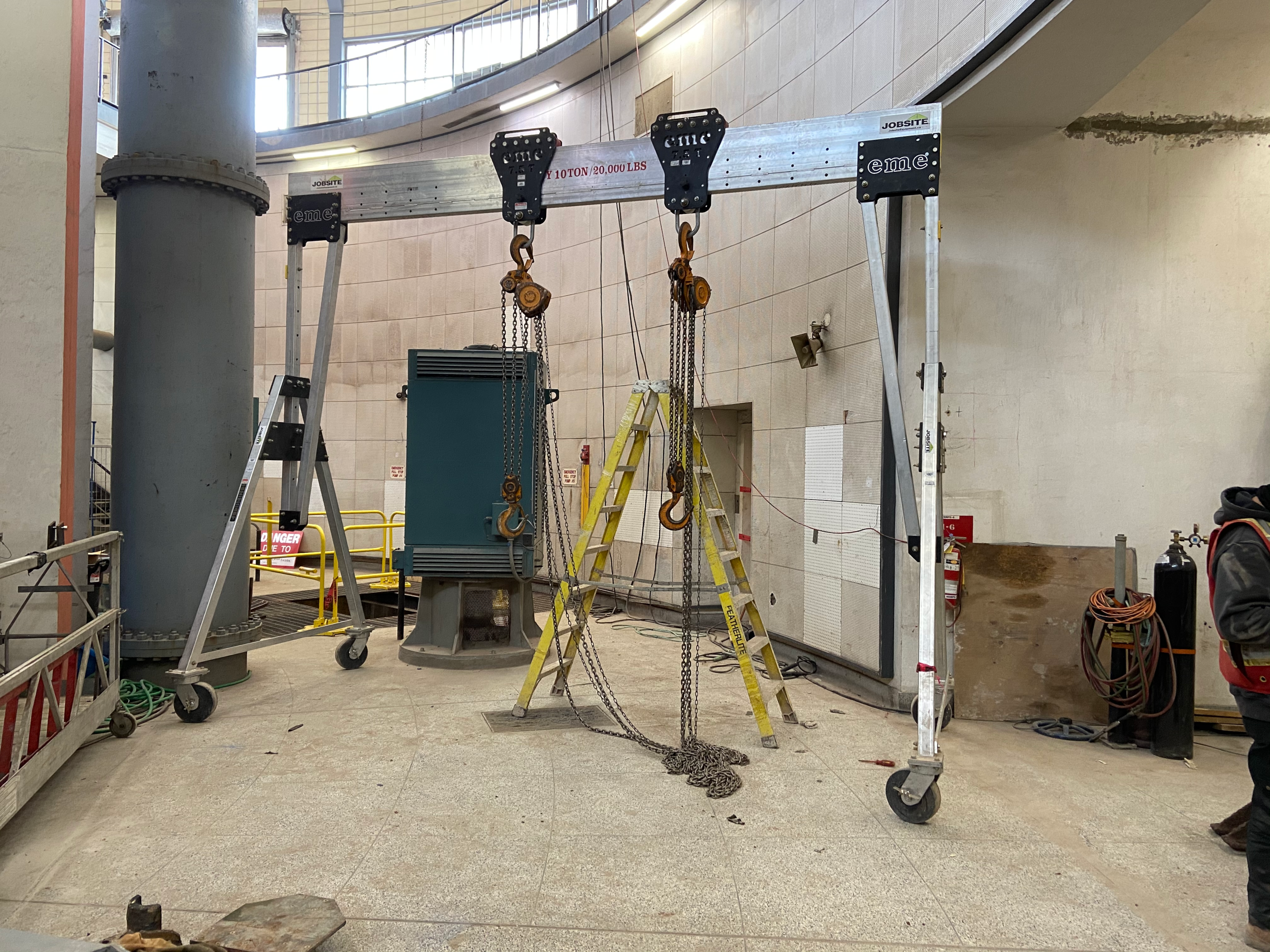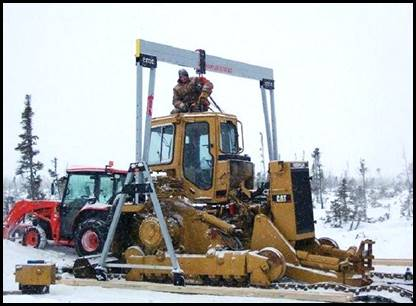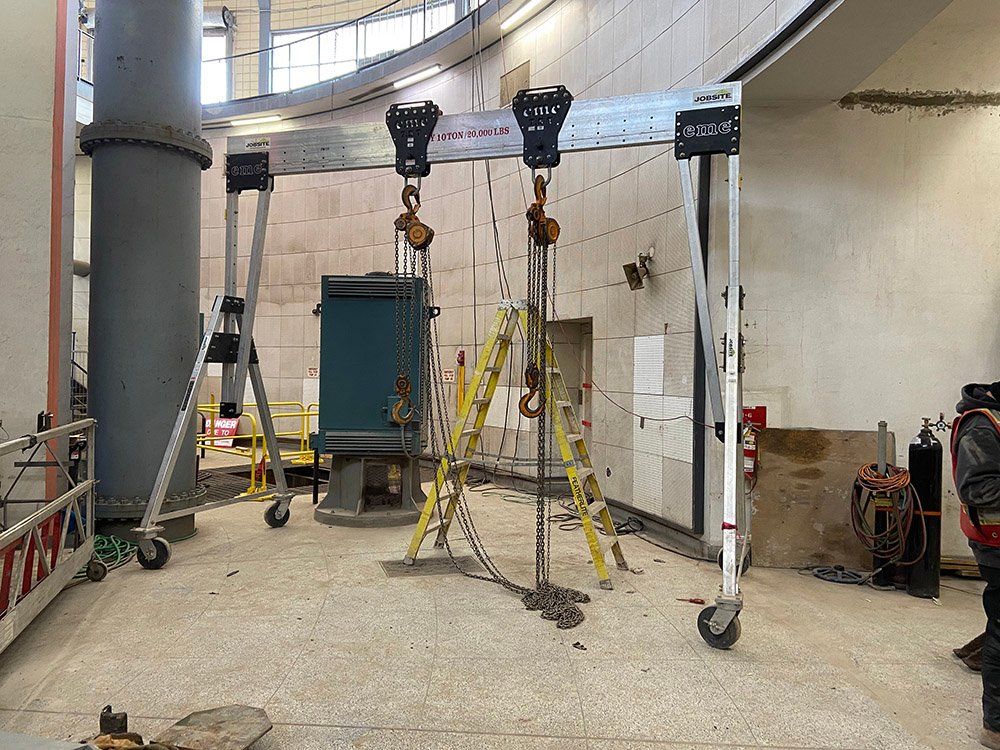Are you in the lifting business? A gantry crane is often the answer to your lifting needs! In this article, we’ll explore a couple of complimentary lifting tools, their uses, and important safety tips to keep in mind. Down below we will dive deeper to help structure your decision making process.
Types of Cranes, along with Forklifts & Hoists
Cranes
Cranes are one of the most commonly used types of lifting equipment. They come in different sizes and shapes, from portable gantry crane systems to mounted or fixed workstation gantry cranes.
Here is a quick list in case you are looking for a specific crane type: Ship crane, portable gantry crane, fixed height steel gantry cranes, lightweight aluminum gantry cranes, stationary gantry cranes, overhead crane, gantry cranes equipped with pneumatic tires, gantry cranes with an enclosed track.
Hoist
A hoist is a machine that lifts heavy loads using a pulley system. A hoist can come in variety of types, including chain hoist, wire rope hoist, and electric hoist. The hoist will hook the load before lifting it.
Operators may also use a below the hook device such as a lifting beam to help balance the load. Gantry cranes are commonly found to use hoists as the mechanism to lift the load.
Forklifts
Forklifts are industrial trucks that are used to lift and move heavy objects. They come in different sizes and can be powered by electricity, gasoline, or diesel.
Often times a forklift will be used in conjunction with a gantry crane. In the case of maintenance work, a gantry crane may lift the heavy machinery and the forklift may be used to reposition or move it.
Gantry Crane: Things to consider
Gantry cranes have a wide variety of possible features and options. Let’s cover a few of essential topics:
Casters
Casters, are attached to the gantry crane leg, allowing the gantry crane to be rolled. Casters come in many different types, but let’s think of them along a couple of different dimensions.
Maneuverability
Depending on your needs, you will want either a rigid or swivel caster. A rigid or fixed caster only allows the gantry crane to be rolled forward and backwards, in a straight line. Sometimes you might see a fixed caster mounted to rails. By contrast, swivel casters will allow the operator to “steer” the gantry crane, since the caster can rotate in a 360 degree manner.
Wheel type
Do you plan to use your gantry crane for indoor or outdoor applications? What type of running surface will the wheels be on? Answering those questions will help decide if you want a hard phenolic surface or a softer rubber wheels. If you plan to roll the gantry while loaded, make sure you double check the material on your caster!
Type of Material
Steel vs Aluminum: Materials will dictate how heavy your crane will be. Steel gantry cranes used to be the industry standard, but they have been getting replaced by modern aluminum gantry cranes. Steel is heavier and is useful to use in very large gantries that require capacities above 10 tons.
Aluminum materials are obviously lighter with a high strength to weight ratio. Aluminum gantries are typically portable gantry cranes. The advantage of the lightweight design makes them more portable and easier to transport to a different location, compared to steel gantries. Also note that an aluminum portable gantry crane is likely easier to store since it is lighter.
Beam Type
I beam vs Hollow: The I beam is the traditional type of beam used in gantry cranes. The I beam has some draw backs for the user. You can’t build the gantry from the ground up, since the beam needs to be placed directly on the legs after they have been erected. Flanges on the beam that are used to hold the beam trolley can be different depending on the manufacturer. This can complicate how the trolley is installed, which may be a safety issue.
A hollow beam makes it possible for the operator to build the gantry from the ground up, since it can slot into the cheek plates of the gantry crane. The beam trolley will roll along the top of the beam (eliminating guess work about the flanges), often creating a smoother motion while shifting the load.
Capacity
What is the intended object you plan to lift?
Deciding on the correct lifting capacity is critical to the safety of your lift. As an example, in certain industries, such as the HVAC industry, to service an industrial air conditioner might require 2 tons of lifting capacity. However, in let’s say the energy industry, such as an energy plant, then you might need 5 tons of lifting capacity to service the machinery involved in energy production.
Obviously very high capacity cranes with 15 tons or higher would be used in a single location, since their size makes them difficult to store or ship.
Some portable gantry cranes have been developed with a high lifting capacity – talk about a well designed piece of lifting equipment!
Fixed or Adjustable
Fixed height gantries are often designed for a repetitive process such as material handling. These gantries might be installed on a track or in a specific area where they will be used. These types of gantries would often have a very high capacity.
If you plan to do maintenance work, then an adjustable gantry crane makes more sense. The physical structure might present a tight workspace such as low ceilings and narrow hall ways. Also consider how you plan to store the unit.
An adjustable gantry will be easier to store since you can reduce it to the lowest height. Gantry cranes can be adjustable for both span and height, so make sure to do your homework to understand your needs, this will help filter out cranes wouldn’t make an ideal purchase.
Span
How wide do you need your clear span to be?
This is one of the most important questions to answer. If you are lifting a piece of equipment that spans wide or navigating a structure with an opening in the floor, then you will need a wider beam to give more distance between the legs.
Conclusion
As can be seen from our brief discussion above, there are a number of parameters to consider before you shop for a crane.
As you start to shop, price may also be a factor in your decision making process. However, don’t just solve for price.
Also consider how long you expect the equipment to last and the manufacturer’s track record of shipping cranes with defects. A crane that will last maintenance free for 10 years will be a better purchase than buying a cheap crane that’s on sale in an online store.
At Easily Moved Equipment (eme) we have the broadest portfolio of aluminum cranes in North America. Email or call us at 888-679-5283 to find out how we can help you!





0 Comments